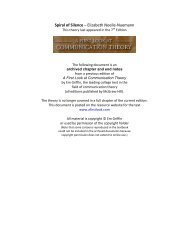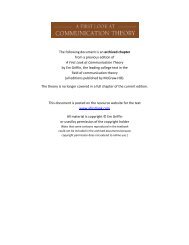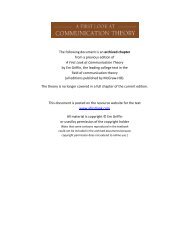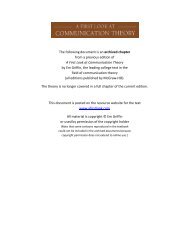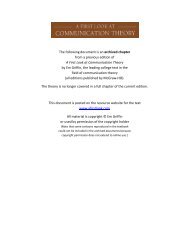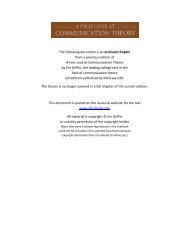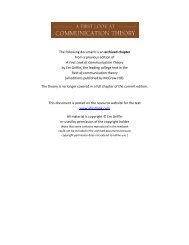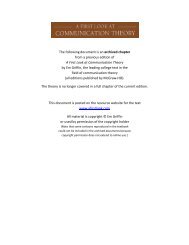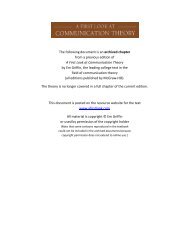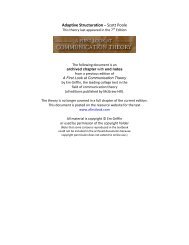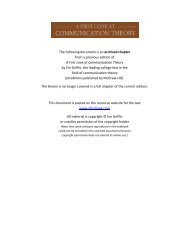Hierarchy of Needs (PDF) - A First Look at Communication Theory
Hierarchy of Needs (PDF) - A First Look at Communication Theory
Hierarchy of Needs (PDF) - A First Look at Communication Theory
You also want an ePaper? Increase the reach of your titles
YUMPU automatically turns print PDFs into web optimized ePapers that Google loves.
132 1NTRAPERSONAL COMMUNICATIONCRITIQUE: MASLOW AS THE FATHER OF THE “ME GENERATION”In a sc<strong>at</strong>hing critique entitled “Stepping Off Maslow’s Escal<strong>at</strong>or,” social criticDaniel Yankelovich accuses Maslow <strong>of</strong> providing intellectual justific<strong>at</strong>ion forthe selfish individualism <strong>of</strong> the last two decades. Before agreeing with thecharge, remember th<strong>at</strong> Maslow’s original cluster <strong>of</strong> self-actualized individualsconsisted <strong>of</strong> people who no longer felt the tug <strong>of</strong> deficiency needs and werefreed up to help others. Somehow this selfless component has been ignoredby Maslow’s disciples, and self-fulfillment has come to mean “look out fornumber one.” Yankelovich notes th<strong>at</strong> it’s not fair to blame Maslow for theexcesses <strong>of</strong> his followers, yet in the end he does so.Perhaps Maslow was overly optimistic about human goodness. His idea<strong>of</strong> an inn<strong>at</strong>e, positive direction is hard to accept after w<strong>at</strong>ching a film on theHolocaust or reading reports <strong>of</strong> torture from Amnesty Intern<strong>at</strong>ional. Certainlywe have the capacity for good. But history doesn’t support the claim th<strong>at</strong> beingtrustworthy, loyal, helpful, friendly, courteous, kind, and so forth, is thedominant human tendency.Maslow’s theory <strong>of</strong> motiv<strong>at</strong>ion does have a healthy emphasis on freedom<strong>of</strong> choice. He believes th<strong>at</strong> the ability to respond is wh<strong>at</strong> makes us fullyhuman. With this in mind, one might wish th<strong>at</strong> he had placed more emphasison responsible, unselfish commitment to others. For the past few thousandyears, communic<strong>at</strong>ion pr<strong>of</strong>essionals have recommended th<strong>at</strong> speakers concentr<strong>at</strong>eon the needs <strong>of</strong> their audience r<strong>at</strong>her than focusing on their owndesires. In spite <strong>of</strong> the turned-in focus <strong>of</strong> the last decade, the advice stillseems sound.QUESTIONS TO SHARPEN YOUR FOCUS1. Maslow’s humanistic approach was a reaction against Freudian and behavioristicpsychology. How does the “Third Force” differ from these other twoapproaches?2. Given th<strong>at</strong> safety needs are lower in the hierarchy than needs for love andesteem, how is it possible th<strong>at</strong> people might willingly die for their country?3. Wh<strong>at</strong> has been the single most joyous, happy, or blissful moment <strong>of</strong> yourlife? Does th<strong>at</strong> peak experience square with Maslow’s description <strong>of</strong> self-actualiz<strong>at</strong>ionas an unselfish st<strong>at</strong>e?4. Is there any place for delayed gr<strong>at</strong>ific<strong>at</strong>ion within Maslow’s theory <strong>of</strong>motiv<strong>at</strong>ion?A SECONDLOOKRecommended resource: Abraham H. Maslow, Motiv<strong>at</strong>ion and Personality, 2d ed.,Harper & Row, New York, 1970.



